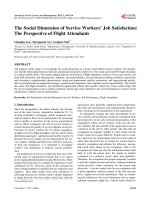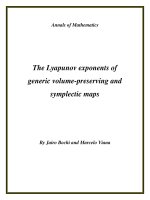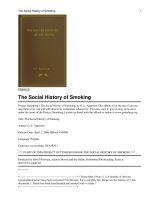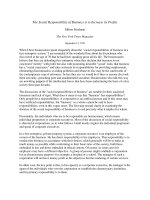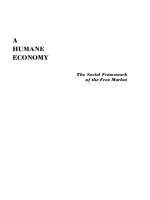Economic wealth creation and the social division of labour volume i institutions and trust
Bạn đang xem bản rút gọn của tài liệu. Xem và tải ngay bản đầy đủ của tài liệu tại đây (7.1 MB, 301 trang )
RobertP.Gilles
EconomicWealthCreationandtheSocialDivisionof
Labour
VolumeI:InstitutionsandTrust
RobertP.Gilles
ManagementSchool,Queen’sUniversityBelfast,Belfast,UK
ISBN978-3-319-76396-5 e-ISBN978-3-319-76397-2
/>LibraryofCongressControlNumber:2018945055
©TheEditor(s)(ifapplicable)andTheAuthor(s)2018
Thisworkissubjecttocopyright.Allrightsaresolelyandexclusivelylicensedbythe
Publisher,whetherthewholeorpartofthematerialisconcerned,specificallytherightsof
translation,reprinting,reuseofillustrations,recitation,broadcasting,reproductionon
microfilmsorinanyotherphysicalway,andtransmissionorinformationstorageand
retrieval,electronicadaptation,computersoftware,orbysimilarordissimilarmethodology
nowknownorhereafterdeveloped.
Theuseofgeneraldescriptivenames,registerednames,trademarks,servicemarks,etc.in
thispublicationdoesnotimply,evenintheabsenceofaspecificstatement,thatsuchnames
areexemptfromtherelevantprotectivelawsandregulationsandthereforefreeforgeneral
use.
Thepublisher,theauthorsandtheeditorsaresafetoassumethattheadviceandinformation
inthisbookarebelievedtobetrueandaccurateatthedateofpublication.Neitherthe
publishernortheauthorsortheeditorsgiveawarranty,expressorimplied,withrespectto
thematerialcontainedhereinorforanyerrorsoromissionsthatmayhavebeenmade.The
publisherremainsneutralwithregardtojurisdictionalclaimsinpublishedmapsand
institutionalaffiliations.
ThisPalgraveMacmillanimprintispublishedbytheregisteredcompanySpringerNature
SwitzerlandAG
Theregisteredcompanyaddressis:Gewerbestrasse11,6330Cham,Switzerland
Preface
Thisbookisfoundedonmorethan30yearsofreflectionontheuseandabuseofeconomic
theory.Duringtheseyears,Ihaveconsideredmyselftobeacriticalobserverofdevelopments
ineconomicsandineconomictheoryinparticular.Theimpetusformyviewofeconomics
presentedherewasgiven,initially,duringmystudiesasaneconomicsstudentatTilburg
Universityand,subsequently,duringresearchformydissertation.Mydissertationaddressed
themodellingofinstitutionalconstraintsinEdgeworthianbarterprocesses.Duringthese
initialyearsasaresearcherineconomics,Ialreadyfoundmyselfatoddswiththemain
hypothesesputforwardbyleadingeconomists.Inparticular,Ilamentedthestateofgeneral
equilibriumtheoryanditssingularfocusonperfectlycompetitivemarkets,whichIbelieveto
bemuchtoolimiting.
DuringmysubsequentcareeratVirginiaTechIturnedmyattentiontoseveralotherareas
ineconomictheory.Again,Ifoundthepracticeintheseotherfieldsineconomictheory
lackingincriticalself-reflection.Imadeseveralcontributionstothegeneralequilibrium
theoryoftheprovisionofcollectivegoods-betterknownaspublicgoods.Withmycoauthors
DimitriosDiamantarasandPieterRuys,wehavebeenabletoapplythistheorytounderstand
theemergenceoftradeinstitutions,inparticularmarketsystems,thataresubjectto
establishmentandmaintenancecosts.Ourconclusionsfromthisresearchresultedin
explanationsthatweredifferentfromtheestablishedtheoriesinmainstreamneo-classical
economics.
Subsequently,Iinvestigatedtheformationofnetworksandhierarchicalauthority
organisationswithvariouscoauthors.Inparticular,Ifocusedontheroleoftrustinthe
formationofnetworksundermutualconsent.Themaininsightfromthisresearchisnotonly
thattrustremovesambiguityaboutnetworkingdecisions,butalsothattrustguidesthe
variouseconomicagentstoformasocialnetworkwithstrongstabilityproperties.
IfirstmetXiaokaiYangduringavisittoTilburgUniversityin1999.Myreadingofhis2001
bookonthesocialdivisionoflabourtriggeredmyinterestinincorporatingsomeofmyown
ideasinYang’sframework.IttookalongtimetotrulyunderstandtheworkingofYang’s
theoryanditsfullpotential.OnlyyearsafterhisdeathwasIabletofullyrealisethispotential
inamathematicallycorrecttheoryofwealthcreationthroughasocialdivisionoflabour.The
resultshavebeenbeyondmyexpectations,andIhaverealisedthatthisframeworkcould
unifymanyofmyideasfrommypreviousresearchandintrospection.
Immediatelyfollowingthefinancialcrisisof2008,IreturnedfromtheUSAtoEuropeand
tookupaprofessorshipatQueen’sUniversityinBelfast,UK.Thecrisisstrengthenedmy
resolvetoturnmultiplestrandsofresearchandteachingmaterialintoacomprehensive
visionofthefunctioningofaneconomy.Thistheoryshouldbeabletoexplainthecrisisand
makeitpossibletounderstanditseffects.
DuringthepastdecadeatBelfastIhavedevelopedandtaughtmyemergingvisionofthe
network-institutionalnatureofeconomicwealthcreationthroughasocialdivisionoflabour.
Thisvisionispresentedintwovolumes.
Thisfirstvolumediscussesthenetwork-institutionalfoundationofeconomicwealth
creationthroughasocialdivisionoflabour.Thetheoryputforwardemphasisestheroleof
socio-economicinstitutionsinguidingthesocialdivisionoflabour.Itbringstogethermy
thoughtsonhowinstitutionsstructureoureconomyandfacilitatetheproductionofgoods
andservices.Idiscusshowthisallowsustounderstandthefinancialpanicof2008andwhat
happenedrecentlyintheglobaleconomy.Italsoallowsforacomprehensiveunderstandingof
thenatureandroleoftrustandentrepreneurship.Bothareessentialelementsinthe
functioningofwealthcreationprocessesinasocialdivisionoflabour.
Whilethenatureofthefirstvolumeisverymuchintherealmofpoliticaleconomy,Iturn
tomathematicalmodelsofeconomieswithasocialdivisionoflabourinthesecondvolume.
ThereIamabletobuildontheframeworklaidoutinthefirstvolumetodevelopinsightsin
thefunctioningoftheseeconomies.Inparticular,thesetheoriesexplainthat,ifeconomic
wealthisgeneratedthroughasocialdivisionoflabour,thereisinprinciplenocontradiction
betweentheclassicallabourtheoryofvalueandtheneo-classicalmarkettheoryofvalue.This
onlyemergesifinstitutionsareassumedtoimplementastateofperfectcompetitionand
mobility:institutionalimperfectionsallowtheemergenceofmiddlemeninthenetworksthat
makeupthetradeinfrastructureoftheeconomy.This,inturn,createspositionsofpowerthat
canbeexploitedtocreateinequalitiesanddeviationsfromtheunderlyingvalueofthetraded
commodities.
Acknowledgements
Thisbookcouldnothavebeenwrittenwithoutthehelpfulinputofmanyofmycolleaguesand
students.Manydiscussionsovertheyearshaveshapedtheresearchandphilosophy
presentedhere.StartingwithmydissertationresearchatTilburgUniversityinthe
Netherlandsinthe1980sandsubsequentlymyworkatVirginiaTechinBlacksburg,Virginia,
andQueen’sUniversityinBelfast,UK,Ihavehadmanyopportunitiestoshapemythoughts
throughinteractionswithcolleaguesandstudentsandthroughlecturingtoattentive
audiences.
Aboveall,Iacknowledgethecontributionsofmymentor,PieterRuys,tothematerial
presentedhere.Wehavebeendebatingthenatureoftherelationaleconomyfor30yearsand
wecontinuethisdebatetoday.IntheearlydaysofmydissertationresearchatTilburg
University,Pietergavemethefreedomtofindmyownwayandinvestigatenetworksand
hierarchieswellbeforethesebecamefashionable.Pieterthengaveandstillgivesmethe
inspirationtoaskthehardquestionsandtodemandthateconomists,andeconomictheorists
inparticular,shouldprovideanswerstothesequestionseventhoughthesearchis
tremendouslydifficultanddemanding.
Second,IacknowledgethecontributionsofDimitriosDiamantarastotheideasand
conceptspresentedhere:Dimitrioswasmycoauthorindevelopingmanyofthesetheories.
Wespentalotoftimetogethertodevelopthedemandingmathematicalmodelsandproofs
thatarerequiredtoaddressthesequestionsproperly.IthankDimitriosandhisstudentMarie
Shorokeyfordetailedcorrectionsandfeedbackonthisfirstvolume.
Morerecently,myworkwithDimitriosandMarialauraPesceontheendogenous
emergenceofasocialdivisionoflabourindifferentinstitutionalenvironmentshasbeen
inspiringandisamajorpartoftheideaspresentedinthesecondvolume.IthankMarialaura
forhostingmeinNaplesthesepastyearstodeveloptheseideasmorefully.
Ialsothankmyformerstudents,manyofwhomarenowclosecolleaguesand
collaborators.Inparticular,workingwithRenévandenBrinkandEmiliyaLazarovahasgiven
memuchinspiration.Wewrotemanypaperstogether,withRenéonhierarchical
organisationsandwithEmiliyaontherelationaleconomyandinstitutions.
WithSudiptaSarangiIdevelopedoneofthemostimportantconceptsandmodelsinthis
researchprogramme,themodelofnetworkformationundermutualconsent.Ourmodelof
trustingbehaviourandthegametheoreticsolutionformsinmanywaysacornerstoneofmy
researchprogramme.ThisresearchextendedintoourworkwithSubhadipChakrabartionthe
manyapplicationsofnetworksingametheoreticmodelsofeconomicbehaviour.
WorkingwithKateJohnsonhasbeenarealinspiration.Togetherweexploredthenotion
ofsocialcapital,Grameenbankingandexperimentalgametheory.Manyofourdiscussions
arehopefullyreflectedinthistext.
Mostrecently,OwenSimshascontributedmostprolificallytothediscussionofhowthe
socialdivisionoflabourdevelopsand,particularly,ourunderstandingofentrepreneurshipin
sucheconomies.Ourdebatesandjointresearchhasresultedinmanyideasthatarepresented
inthisfirstvolume.Chapter5onentrepreneurshipisajointworkwithOwen.Hisinterestin
historicalcasesofentrepreneurshipmatchedmyownandresultedinveryinsightfulanalysis
thatisusedthroughoutthisvolumeandChap.5specifically.IthankOwenverymuchforthese
contributions.Withouthimthisprojectwouldbemuchlesscomplete.
IwouldalsoliketothankmyformerstudentsWillySpanjers,KyungdongHahn,Narine
BadasyanandZhengzhengPan.Overtheyears,theygavememuchmotivationtokeepon
trackwithmyworkontheresearchprogrammethathasresultedinthesetwovolumes.
Finally,IthankmywifeJelenaforputtingupwithmyidiosyncraticstateofmindandwork
ethicduringtheendlesshoursofworkingonthismanuscript.Iamverygratefultoherfor
allowingmeamorepracticalperspectiveonthefunctioningofthesocialdivisionoflabour
throughherlensofsupplychainmanagement.ShecomplementsmeinmorewaysthanIcan
express.
RobertP.Gilles
Belfast,UK
January2018
Contents
1ThePrinciplesofEconomicWealthCreation
1.1FormulatingaTheoreticalFramework
1.2FundamentalPrinciplesofEconomicWealthCreation
1.2.1HumanSocialityandOrganisation
1.2.2TheNatureofSocio-EconomicTrust
1.3TheSocialOrganisationofEconomicWealthCreation
1.3.1IncreasingReturnstoSpecialisationinProduction
1.3.2GainsfromTrade
1.3.3TheSocialOrganisationofEconomicWealthCreation
1.4TheFunctioningoftheSocialDivisionofLabour
1.4.1TwoViewsonEconomicWealthCreation
1.4.2TheRelationalNatureofEconomicInteraction
1.4.3TransactionEfficiencyandtheExtentoftheMarket
1.4.4EconomicDevelopmentandtheEntrepreneurialFunction
1.5BringingitTogether:AFirst,SimpleModelofWealthCreation
1.5.1InstitutionsandWealthGenerationinaHunter-GathererEconomy
1.5.2TheConsequencesofRicardianDevelopment
1.5.3SmithianDevelopmentinaSocialDivisionofLabour
1.6SomeFurtherConsiderations
Appendix:TheNatureofMarkets
References
2OfBubblesandCrises:AHistoryofWealthCreation
2.1InstitutionalWaves
2.2AVeryShortHistoryofEconomicWealthCreation
2.2.1DevelopmentBeforeCapitalism
2.2.2TheInstitutionalDevelopmentLeadingtoCapitalism
2.2.3TheRebirthofthePlatonianEconomy
2.2.4TheCapitalistEconomy
2.3BubblesandCrisesinthePlatformEconomy
2.3.1SettingtheScene:TwoMajorCrisesofCapitalismBefore2008
2.3.2TheRun-UptotheGreatPanicof2008
2.3.3TheSubprimeMortgageProvisionSystem
2.3.4SomeDirectCausesoftheGreatPanicof2008
2.4LookingtoaPossibleFuture:TheNetworkEconomy
References
3AFrameworkforModellingWealthCreation
3.1TheStructureofaSocio-EconomicSpace
3.2Governance:TheRoleofInstitutions
3.2.1ATypologyofSocio-EconomicInstitutions
3.2.2AnIllustration:ComparingThreeInstitutionalTradeInfrastructures
3.3InteractionInfrastructures
3.3.1FormsoftheSocialDivisionofLabour
3.3.2APrimeronNetworkAnalysis
3.3.3CommodityMarketsasTradeNetworks
3.3.4ANetworkPerspectiveontheLawsofDemandandSupply
3.4TheEntrepreneurialFunction
3.4.1IndividualEntrepreneurship
3.4.2CollectiveEntrepreneurship
References
4EconomicRelationshipsandTrust
4.1TheBehaviouralEconomicPerspectiveofTrust
4.2TrustasaDuality
4.2.1InstitutionalTrustastheDualofEmbeddedness
4.2.2DailyLife:OperationalConfidence
4.3AReconstructionofEmbeddednessandTrust
4.3.1ReconstructingEmbeddedEconomicInteractions
4.3.2TheTripolarReconstructionofTrustasaDuality
4.4WhatConstitutesEconomicActivity?
References
5TheEntrepreneurialFunction
5.1EstablishedPerspectivesontheEntrepreneurialFunction
5.1.1TheDeficiencyoftheNeo-ClassicalPerspective
5.1.2TheSchumpeterianTheoryofEntrepreneurship
5.1.3TheBurtianTheoryofEntrepreneurship
5.2InstitutionsandtheEntrepreneurialFunction
5.2.1InstitutionalEntrepreneurship:ALiteratureSurvey
5.2.2EntrepreneurshipintheSocio-EconomicSpace
5.2.3InstitutionsandtheUniqueNetworkPositionsofEntrepreneurs
5.3Case:TheEntrepreneurshipoftheHouseofMedici
5.3.1RestructuringtheInstitutionalMatrix:TheCiompiRevolt
5.3.2Giovannide’MediciasanInstitutionalEntrepreneur
5.3.3ThePoliticalEntrepreneurshipofCosimode’Medici
5.4TheInteractionofNetworks,InstitutionsandEntrepreneurs
References
Index
ListofFigures
Fig.2.1SchematicofthenetworkofUSmortgageprovision(1950s)
Fig.2.2SchematicofthenetworkofUSmortgageprovision(2007)
Fig.3.1Stylisticrepresentationofasocio-economicspace
Fig.3.2Anexampleofalateralnetwork
Fig.3.3APlatonianproductionnetworkforbread
Fig.3.4Aneuralnetworkforinformationprocessing
Fig.3.5Aproductionnetworkforbreadwithpowerrelationships
Fig.3.6Ahierarchicalnetwork
Fig.3.7Astricthierarchy
Fig.3.8Anorganisedmarket
Fig.3.9Anetworkrepresentationofamatchingmarket
Fig.4.1Graphicalrepresentationofanembeddedrelationship
Fig.4.2Basictripolarrepresentationofaneconomicinteraction
Fig.4.3Reconstructionoftheactualisationofaneconomicinteraction
Fig.4.4Introducingthenotionalrelationshipinthetripolarreconstruction
Fig.4.5Afullydevelopedtripolarreconstructionofeconomicinteraction
Fig.4.6Trustasthedualofreconstructedinteraction
Fig.5.1Anetworkwithstrongandweakties
Fig.5.2Theroleofbridgesinanetwork
Fig.5.3MarriagenetworkofFlorentinehouses,c.1429
Fig.5.4Lending(red),partnership(blue)andpatronage(black)relationshipsbetween
Florentinehouses
ListofTables
Table2.1Historyoffinancialpanics
Table3.1Basicrankingsofhomesteadsfordifferentcitizens
Table3.2A“jungle”equilibriumbasedonadiscretesocialhierarchy
Table3.3IllustrationoftheSWFforadiscretesocialhierarchy
Table3.4EquilibriuminabartersystemcorrespondingtoTable3.1
Table3.5Basicmonetarywillingness-to-payvalues
Table3.6Step1—excessdemandsatzeroprices
Table3.7Step2—excessdemandanalysis
Table3.8Step3—excessdemandanalysis
Table3.9Step4—excessdemandanalysis
Table3.10Step5—excessdemandanalysis
Table3.11Step6—excessdemandanalysis
Table3.12Allocationα—anequilibriumallocationafterpriceadjustment
Table3.13Allocationβ—analternativeequilibriumallocation
©TheAuthor(s)2018
RobertP.Gilles,EconomicWealthCreationandtheSocialDivisionofLabour
/>
1.ThePrinciplesofEconomicWealthCreation
RobertP.Gilles1
(1) ManagementSchool,Queen’sUniversityBelfast,Belfast,UK
RobertP.Gilles
“Whatarethecausesofthehumanabilitytocreateeconomicwealth?”Thisisoneofthekey
questionsthathaveoccupiedeconomistsfromtheonsetoftheirreasoningabouteconomic
activityandperformanceinahumansociety,exemplifiedbythetitleofthemagnumopusby
AdamSmith(1776),AnInquiryintotheNatureandCausesoftheWealthofNations.
Theresponsetothisfundamentalquestionisnotonlytheoldest,butalsothemost
establishedeconomictheory:wealthisgeneratedthroughasocialdivisionoflabourthatis
encapsulatedinasocialtradeinfrastructure.Productivetasksarespreadoutamonga
multitudeofindividuals,whoachievecollectivelyahigheroutputthanwhenallofthem
remainnon-specialised.Thuswealthgenerationisfoundedon“IncreasingReturnsto
Specialisation”.Throughasocialtradeinfrastructurethesespecialisedproductiveindividuals
arebroughttogethertoexchange,barterandtradethefruitsoftheirlabourtoallocatethe
collectiveoutputforconsumptivepurposes.
Asocialdivisionoflabour,therefore,dividesandintegratessimultaneously.Inorderto
accesstheidentifiedIncreasingReturnstoSpecialisation,productivetaskshavetobe
divided;similarly,thesedividedtaskscanonlybefunctionallyimplementedwhentheyare
integratedintoasocialenvironmentthatembodiesaneffectivetradeinfrastructure.Human
needsgiverisetothedoublecoincidenceofwantsthatcanonlyberesolvedthroughsucha
tradeinfrastructure.
Theabilitytocreatesuchacomplexsocialorganisationandtoletthisorganisationbe
sufficientlyflexibleisuniquelyhuman.Infact,thehumanconditionisexemplifiedbythis
uniquesocialability.OurhomininspeciesHomosapienssapiensevolvedbiologicallyaswell
associallytorespondtoenvironmentalconditionsinacooperativemanner,thisisknownas
the“socialbrainhypothesis”(Dunbar2003).Thesocialbrainhypothesisleadstothe
conclusionthatthisuniquelyhumancharacteristicnaturallyevolvedintosuchasocial
divisionoflabour.
Thatthesocialdivisionofwealth-generatingtaskscannotbeseparatedfromits
integrationthroughasocialtradeinfrastructuregivesrisetoquestionsabouthowahuman
societyaccomplishessuchadifficultandcomplexobjective.InthisworkIadoptthe
hypothesisthatsuchanorganisationisconductedandcoordinatedthroughsocio-economic
institutions.Theseinstitutionsareunderstoodasfictionalnarrativesthatbuildaparallel
fictionalrealityinwhichhumansinteractandcooperate(Harari2014).
Suchaninstitutionalperspectiveis,therefore,inalienablefromtheideathatwealthis
generatedthroughasocialdivisionoflabour.Thishasbeenacceptedbymanysocial
philosophersandeconomists,buthasbeenneglectedmorerecentlyinmarket-centred
thinkingaboutthehumaneconomy.Iargueherethatareturntoamoreinstitutional
perspectiveisnecessarytomakeeconomicsrelevantagainandtoaddresscontemporary
issuesintheglobaleconomyinthetwenty-firstcentury.
Theinstitutionalperspectivetakeninthisbookisaverybroadone,capturingmanyforms
ofthefictionalnarrativesthatguidehumaninteraction.Iincludeallformsofconventions,
collectivebehaviouralrulesandformsofgovernanceinthecategoryofinstitutions.
Institutionsrange,therefore,fromsimplehumangestures,facialexpressionsandlanguageto
advancedgovernmentalinstitutionsandsophisticatedfinancialinstrumentsinour
contemporaryglobaleconomy.
Inthischapter,Isetoutanaxiomaticstructuretounderpinathoughtframeworkinwhich
onecanmeaningfullyreasonaboutthehumaneconomycentredaroundasocialdivisionof
labour.Beforedoingthis,Idwellforashorttimeonthehistoricalrootsofthefundamental
theorythateconomicwealthisgeneratedthroughasocialdivisionoflabourthatis
encapsulatedinaneffectivetradeinfrastructure.
SomeHistoricalTheoriesoftheSocialDivisionofLabour Theideaorprinciplethat
economicwealthgenerationisconductedthroughsuchasocialdivisionoflabourwasalready
proposedinancientGreeksocialphilosophicaldiscourse.Thisisexemplifiedbythe
descriptionoftheideal“polis”inPlato(380BCE)asanurbaneconomythatisstructured
throughaclearsocialdivisionoflabour.Thiswasexpoundedandexpandeduponby
Xenophon(370BCE,362BCE),whoemphasisedthenecessityofhavingaproperfunctioning
institutionalenvironmentinwhichasocialdivisionoflabourcanflourish.
Aristotle(350BCE)developedtheconceptionofeconomicwealthcreationthrougha
socialdivisionoflabourinitsmostcompletevisionduringGreekantiquity.Heemphasised
theimportanceofspecificsocio-economicinstitutionssuchaspropertyrightsandthefree
exchangeandbarterofproperty.Thisincludedatreatiseontheevolutionofmoneyandthe
foundationofthepricemechanism(Aristotle340BCE,BookV).
Theprinciplethateconomicactivityisstructuredasasocialdivisionoflabourwas
unquestionedthroughmorethan2000yearsofphilosophicalandsocialthoughtspanning
Plato,XenophonandAristotle.ContributionsweremadeinIslamicScholasticandLatin
Scholasticthought(Sun2012,Chapter2),butonlyduringtheperiodintherun-uptothe
industrialrevolutionintheseventeenthandeighteenthcenturieswastheideasignificantly
revived.Theterm“divisionoflabour”wasactuallycoinedbyBernardMandevilleinan
elaborateanalysisofindustrialshipbuildingandcloth-makinginVolume2ofhismagnum
opus,Mandeville(1714).Inthiswork,theconceptthateconomicwealthisgeneratedthrough
asocialdivisionoflabourbecameabsoluteandindisputable.Mandevillealsousesmetaphors
topromotethisidea,inparticularwithhisfamousfableofthebees.
Mandevillebroughttheideasoftheancientsocialphilosophersintotheworldcreatedby
theindustrialrevolution.Hiscontributionalsoincludedtheintroductionoftheideaofthe
channellingofself-interestthroughthetradeinfrastructureoftheeconomy.AsPrendergast
(2016)argues,thiswasnotnecessarilyfoundedonanearlyunderstandingof“laissez-faire”
economicpolicybygovernmentsofnation-states—thatunbridledself-interesteddecision-
makingleadstocollectivelyoptimalbenefitsunderfreetrade—butratheramore
sophisticatedconceptionoftheroleofpublicgovernmentintheeconomy.Inparticular,
Mandevillewashesitantaboutthepotentialforcoercioninthelabourmarketsinamodern
industrialeconomy.
ClassicalPoliticalEconomy Althoughtherootsoftheemergingfieldofpoliticaleconomy
werealreadylaidpriortohiscontributions,AdamSmith(1759,1776)firmlyestablishedthis
newscienceonthefundamentalprinciplethateconomicwealthwasgeneratedthrougha
socialdivisionoflabour.ThiswassetoutinthefirstthreechaptersofSmith(1776),inwhich
hefamouslyexpoundedontheworkingsofthedivisionoflabourinapinfactory.
Smithalsodevelopedsometheoreticalconsequencesofthehypothesisofwealth
generationthroughadivisionoflabour.Inparticular,helinkedtheproperandefficient
functioningofasocialdivisionoflabourtothenotionofcompetition,anddevelopedthe
notionofthe“extentofthemarket”todescribethelimitsofthewealthgenerationprocessin
asocialdivisionoflabour.Thisleadshimontoanextensivedebateabouteconomicpolicy
foundingthedevelopmentoftheeconomy—embodiedbythesocialdivisionoflabour—
basedoneconomiclibertyandself-guidance.ThiswasexpressedmostforcefullyinSmith’s
conceptofthe“invisiblehand”:thatselfishnessandgreedguidethesocialdivisionoflabour
toitsmostoptimalstate.
AfterSmith,DavidRicardo(1817)providedthenextpushinthedevelopmentofthe
theoryofwealthgenerationthroughasocialdivisionoflabour.Basedonthevisionpromoted
byMalthus(1798),Ricardowasveryconcernedaboutthelimitstoeconomicgrowth.He
introducedthetheoreticalnotionsofmarginalproductivityandanequilibriumasastateofthe
economyinwhichtherateofreturnoncapitalinvestmentsisnegligibleowingtothebalance
oftheforcesinthesocialdivisionoflabour.1Ricardothusintroducedtwofundamentalideas
intoeconomics—marginalismandequilibration—changingeconomicthoughtforever.
Ricardosignificantlychangedthetheoryofwealthgenerationthroughasocialdivisionof
labour,settingthesceneforcontributionsthatconsideredtheincorporationofthedivisionof
labourintomanufacturingorganisations.Thefirstmaincontributiontotheunderstandingof
manufacturinganditseffectsonthedivisionoflabourwasmadebyCharlesBabbage(1835).
Heformulatedthe“Babbageprinciple”thatinanindustrialisedeconomyIncreasingReturns
toSpecialisationaredrivenbyadvancesinproductiontechnologyandtheorganisationof
workaroundmechanisedproductionprocesses.Thislaidthefoundationsformodern
economicgrowththeory.
TheworkofBabbageonmanufacturingsetthesceneforthemostcomprehensiveanalysis
oftheindustrialdivisionoflabourintheworkbyKarlMarx(1867,1893,1894).Marxfully
incorporatedtheideathattasksareorganisedhierarchicallyinsocialproduction
organisations—throughamanufacturingdivisionoflabour.Hisanalysisconsideredthefact
thatproducedcommoditiescanobscurethewayinwhichproductionisorganised—referred
toas“commodityfetishism”(Marx1867,Chapter1).Forexample,whenbuyingamobile
phone,itisnotclearhowitwasproducedorwhereitoriginated;whetherchildorslave
labourwasusedinitsproduction;orwhetheritsproductionprocessnegativelyimpactedthe
naturalenvironment.2Marx’stheoreticalframeworkattemptedtorevealtheworkingsand
consequencesoftheseobscuredsocio-economicmechanisms.
Marxsetouttodevelopacompletetheoryofthecapitalisteconomy.Hisperspectivewas
verymuchanineteenth-centuryone,centredonthenotionofacommodityasaphysical
bearerof“usevalue”.Histheorydistinguishescapitalismfromotherformsofsocioeconomicorganisationthroughitsfocusoncapitalaccumulation—generatedsurplusesare
submittedtothesocialdivisionoflabourwiththeobjectivetogeneratefurthersurpluses.
ThisperspectivewasfullyexpoundedinamathematicaltheorybySraffa(1960)andRoemer
(1981).
TheSocialDivisionofLabourintheMarginalistPerspective AfterMarx,economics
transformeditselfradicallyfrompoliticaleconomyintoneo-classicaleconomicsbasedon
marginalistreasoninginmarketenvironments.Insomesense,neo-classicismgavein
completelytocommodityfetishismandfocusedsolelyonthetradeofcommoditiesasvalued
objects,neglectingtheproductionprocessesthroughthesocialdivisionoflabour.Indeed,the
ideathatwealthisactuallygeneratedthroughasocialdivisionoflabourdoesnotplaya
significantpartofeconomictheorisingaboutthemarket:neo-classicaleconomicsfocused
completelyonthedescriptionofthepricemechanismanditspowertoguidetheeconomyto
anefficientstate(Jevons1871;Menger1871;Walras1926;Marshall1890;Pareto1906).Even
thoughneo-classicaleconomicsisfirmlyfoundedonamathematicalapproachtoeconomic
reasoning,therewasnopushtomakeprogressonmathematicalmodelsofeconomicwealth
generationthroughasocialdivisionoflabour.
Thedevelopmentofneo-classicaleconomicthoughtwasfurtheradvancedbythe
contributionsofFriedrichHayek(1937,1945,1960),whoconsideredtheroleofinformation
andknowledgeinamarketeconomy.Hayekemphasisedthatknowledgeplaysakeyrolein
theformationofthesocialdivisionoflabour.Inparticular,theavailabilityofknowledgeis
localisedandiscriticalfortheassumptionofsocio-economicrolesandspecialisationsby
individualagentsintheeconomy.Thedispersedknowledgeinthesocialdivisionoflabouris
transformedintopriceinformationthroughthemarketmechanism,guidingindividualagents
intheprocessestoactuallyorganisethemselvesintoasocialdivisionoflabour.Assuch,this
knowledgetransformationprocessisbottomup:dispersedknowledgeineconomiclocations
istransformedintocentralpriceinformationthatguidesalleconomicdecisions.
Hayekviewedthemarketorpricemechanismastheonlysocio-economicinstitutionthat
cantransformdispersedinformationinthisfashion.Heusedittopromotetheideathatany
well-functioningeconomyshouldbefoundedonsuchamechanism,makingthemarket
economytheonlyviableorganisationform.
Hayek’sviewreversesthelogicofMarxiancommodityfetishism:economicdecisions
shouldbebasedsolelyonpriceinformation,whichactuallytransformsandthusobscuresthe
underlyinglocalisedknowledgethatispresentintheeconomy.Therefore,thisformof
commodityfetishismisagoodthingratherthanabadone.3Hayeksubsequentlyusedhis
theoryofthedivisionofknowledgeasthefoundationofhistheoryofeconomicselforganisationandtheriseofspontaneouseconomicorder.Thesetheorieslieatthe
foundationforneo-liberalismthattookholdofpolicyformationandcorporatemanagement
fromthe1980s.
MarketEconomieswithanEndogenousSocialDivisionofLabour Onlyratherrecently
hasXiaokaiYang(1988,2001,2003)revivedaninterestinthesocialdivisionoflabourasthe
mainsourceofeconomicwealth,anddevelopedamathematicalmodelthatappropriately
representsprice-guidedeconomicdecision-makinginthecontextofasocialdivisionof
labour.Yang’smaininnovationwastheintroductionoftheconceptualnotionofaconsumerproducer.Thismathematicalconstructdescribesaneconomicdecision-makerasonewho
embodiesconsumptiveneedsaswellasproductiveabilities—extendingtheinfamousnotion
ofHomoEconomicus.
YangandNg(1993)andYang(2001,2003)madethecasethattheconsumer-producer
approachcanbeusedtodescribewealthgenerationinaneconomyinwhichthecompetitive
pricemechanismguidestheendogenousformationofasocialdivisionoflabour.4Yangand
Ng(1993)alsoarguedthatotherquestionsabouteconomicwealthgenerationcanbe
addressedinthisframework.Assuch,thistheoryisthereforeapropermathematicalvehicle
torepresentSmithianandRicardianideasconcerningthefunctioningofasocialdivisionof
labouranditsextent.
Thismathematicalframeworkhasbeendevelopedfurtherthroughcontributionsby
DiamantarasandGilles(2004),Sunetal.(2004),Gilles(2017a,b)andGillesetal.(2017).
Thesecontributionsshowthatamathematicaltheoryofthefunctioningofasocialdivisionof
labourfoundedonpriceguideddecision-makingbyconsumer-producersleadstoageneral
frameworkthatcanincorporatetheideasofSmith,RicardoandMarxaswellasWalrasand
Edgeworth.FormoredetailsIalsorefertoGilles(2018).
TowardaComprehensiveFramework Despitetheserecentadvancesinthe
understandingofwealthgenerationthroughasocialdivisionoflabour,someimportant
questionsremainunaddressed.Themostimportantquestioniswhythehumaneconomyhas
evolvedtobeorganisedthroughasocialdivisionoflabour.Neo-classicaleconomicsisclearly
foundedontheprinciplethattheeconomyisorganisedthroughacompetitivemarketsystem
andthatthesocialdivisionoflabourissimplyanoutcomeoftheproperfunctioningofthat
marketsystem.Thiswasnotthefundamentalhypothesisonwhichclassicalpolitical
economywasbased.Instead,inpoliticaleconomythesocialdivisionoflabouritselfhas
primacy,whilethemarketsystemhasessentiallyasupportingrole.
Here,Isetouttodevelopacomprehensiveviewtosolvethisfundamentalquestion.
Recentadvancesinanthropologyandevolutionarybiologyshowthatthehumanspecies
evolvedasathoroughlysocial,cooperativespecies.Theuniquefeaturethatactually
separatesHomosapiensfromotherhominidspeciesisthathumansevolvedtosolve
problemscooperativelyandflexibly.Thisallowedthehumanspeciestoembarkona
trajectoryofsocio-economicdevelopment.Inotherwords,Homosapiensischaracterisedby
itseconomy,organisedthroughasocialdivisionoflabour.Thisevolutionarycharacterisation
ofthehumaneconomyprovidesafoundationforacomprehensiveunderstandingofhowthe
economyfunctionsandhoweconomicwealthisgenerated.
Myargumentisthatthereisaunifyingsocio-economicviewofthehumanspeciesthat
explainstheemergenceofthesocialdivisionoflabourastheprimalhumangeneratorof
economicwealth:Humanityevolvedasaspeciesofsocialnetworkersthatthroughsocial
organisationexploitedtheiruniqueabilitytolearnandbemoreproductiveiffocusedonalimited
setoftasks.ThusHomosapienscombinesitsabilitytosociallyorganiseitselfwithits
characteristicthatlabourissubjecttoIncreasingReturnstoSpecialisation.
Thiscomprehensiveviewpointallowsforaproperunderstandingofhoweconomicwealth
isgenerated,thecrucialroleofsocio-economictrustinthehumansocialorganisationand
howaneconomyfoundedonasocialdivisionoflabourfunctions.Centraltothisviewpointis
theroleofinstitutionsinthehumaneconomy.Indeed,socio-economicinstitutionsguide
humanactivityandallowhumandecision-makerstoproperlyinteractandcooperate.The
competitivepricemechanismisjustoneofthesepossiblesocio-economicinstitutions,but
certainlynottheonlyone.
Fromthisthesis,aperspectiveemergesthattheglobaleconomyisahugecooperative
humanprojectinsteadoftheneo-classicalandneo-liberalviewthateconomicinteractionis
basedoncompetitionratherthancooperation.Thus,itfollowsthateconomicsshould
provideabetterunderstandingaboutthewealthcreationprocessesthatoccurintheglobal
economy;economicsshouldreverttobeinga“worldlyphilosophy”—aswasindeedthe
perspectiveofmanyclassicalpoliticaleconomists,includingAdamSmith,DavidRicardo,John
StuartMillandKarlMarx,butwhichhasbeenlostsincethethirdquarterofthenineteenth
centurywiththeriseandestablishmentofneo-classicaleconomics.
Neo-classicaleconomistsconsidered—andstillconsider—themselveshard,high-brow
scientistswhousemathematicalmodelstounderstandandespeciallymeasureeconomic
behaviourandperformance.Thisscientificprojecthasturnedouttobemuchlesssuccessful
thanaswassetoutattheintroductionofthemathematicalscientificmethodinthe1870s,in
whatisknownasthemarginalistrevolution.Inparticular,afterthefinancialcrisisof
2007/2008andthesubsequentlastingsluggishnessoftheglobaleconomy,economicshas
beenfoundwanting.Manyvoicesarecallingforanewformofeconomics;atheoretical,
mathematicaleconomicsthatisopentoaddressingthepressingquestionsofourtimes,
withoutbeingmethodologicallyconstrainedandrestricted.5
Iwillattempttogobacktotherootsofourunderstandingofthegenerationofeconomic
wealthandjustifytheconceptsusedhere.Thisrequiresmetobringtogetheranumberof
veryoldandnewideastosketchatheoreticalunderstandingofthefoundationsofwealth
creationinourcontemporaryglobaleconomythatisratherdifferentfromtheone
communicatedtousbyneo-classicaleconomists.Therefore,theperspectivesetoutherehas
tobeunderstoodasanattempttocommunicatethattheestablished,neo-classicalviewpoint
isactuallycontrivedinapoliticalway,andhastobeviewedasmuchmoreideologicalthan
scientific(Backhouse2010;Chang2014).Bypresentinganalternativevision,Ihopeto
communicatetheimportanceofcertainaspectsofhumansocio-economicbehaviourand
organisationthatseemtobeneglectedintheprevailingeconomicworldview.
1.1 FormulatingaTheoreticalFramework
InthischapterIdevelopatheoreticalframeworkthatisfoundedonanumberoffundamental
hypothesesabouthumaneconomicwealthgenerationandthelogicalconsequencesofthese
hypotheses.Thiscreatesawell-definedandholisticviewofeconomicwealthcreationand,
consequently,ofaneconomyasawhole.Thishelpsustounderstandtheprocessesthatwe
discerninthepastaswellasthecontemporaryglobaleconomy,settingoutaperspectivethat
definesawell-constructedworldlyphilosophyofhumaneconomicinteraction.Unfortunately,
thisdoesnotmeanthatanall-inclusiveandcompleteperspectiveonourcontemporaryglobal
economyemerges;realityremainstoocomplextocomprehendwithanysetofsimple
conceptsandtheories.
Mostofcontemporaryeconomicsiscentredonthenotionofacommodityandits
generatedvaluesasthemainsubjectofstudy.6Inmyconceptualisation,Istartfromthe
viewpointthattheinfrastructureofsocio-economicrelationshipsfoundedonthesocialand
hierarchicaldivisionoflabourshouldbeourprimefocalpoint.Therefore,thecommodities
areonlyofsecondaryimportance;theyaretheobjectsofeconomictransactionsand
conversionprocessesintheprevailingtradeinfrastructure,butbynomeansfully
characterisethatinfrastructure.Indeed,manycontemporarysocio-economictransactions
concernimmaterialservices.Thesearefullydeterminedbythesocialrelationshipbetween
procurerandprovider,inwhichbothprocurerandproviderareinstrumentalinthe
determinationandresolutionofthatservicetransaction;theservicetransactionis
completelysocialor“relational”.
Iconsiderasimpleexampleofacontemporaryservicecommoditytoextendthis
discussion.Ifoneprocuresahaircut,itisunusualthatthestylistastheprovidercompletely
imposesthechosencut;theselectionofthehairstyleisbasedonthedesiresofthecustomer,
andthehairstylistactsasafacilitatorforthis.Assuch,theprocessismutualand
collaborative,ratherthanonesizefitsall.Aproperinterpretationofthehaircutisthatitisthe
immaterialbeareroftherelationaltransactionbetweentheprocurer(customer)andthe
provider(hairstylist).Thustheproductionprocessismuchlessobscuredthanisthecasefor
materialcommoditiessuchasfoodstuffsandphysicalluxurygoods.
Iarguethatallcommoditiesshouldbeinterpretedinthisfashion.So,commoditieshave
tobeunderstoodascarriersoftheunderlyingproductionprocessesandarerecognisedas
such.7
Thisfitswiththeperceptionthat,inourcontemporarytwenty-first-centuryeconomy,
economicsubjectsareveryconcernedabouttheimpactoftheiractivitiesontheir
environment,socialaswellasnatural:consumerscareaboutwheretheirconsumed
commoditiesoriginate;whethertheproductionprocessesinvolvecorruptpracticessuchas
theuseofchildand/orslavelabour;whethertheseproductionprocessesimposesignificant
externalitiesontheglobalnaturalenvironment;andwhetherthelabelontheproductactually
representsaccuratelywhatsubstancesareusedinitsproduction.Similarly,firmsaremuch
concernedaboutcertainpropertiesoftheirsupplychains,especiallytheirsustainabilityand
resilience.Theseconcerns,insomesense,characteriseourcontemporaryglobaleconomy
anditsrelianceonservicesandinterconnectionsthroughcomplexsocio-economicnetworks.
Thisleadstotheconclusionthatthemainobjectofeconomicstudyshouldbethesocial
organisationofallprocessesconductedthroughthesocialdivisionoflabourandthe
associatedtradeinfrastructure.Thenetworksthatmakeupthistradeinfrastructureshould
bethesubjectofourinvestigationandthefocusofourmodelling,ratherthanonlythe
outputsthatmaterialisefromthese(hidden)processes.Inthatregard,theobjectiveof
economicsshouldbeto“de-fetishise”thesecommodities,touseanexpressionfromthe
Marxianperspective.
Thetheoriesdevelopedhereare,therefore,relationalinnatureandconcernthe
interactionbetweensocialcollaborators.Thisrelationalperspectivehasaninstitutional
foundation.Thedevelopmentofthisisthemainsubjectofthisfirstvolume,whileinthe
secondvolume(Gilles,2018)Iturntothedevelopmentofmorequantitative,mathematical
approachestomodellingeconomicwealthcreationthroughasocialdivisionoflabour.
DevelopinganAxiomaticFramework
InthischapterIsetoutthefundamentalprinciples
ofmyinstitutionalapproach.Idevelopthisframeworkasaformaltreatise.Istatefive
fundamentalhypothesesonwhichmyapproachisfoundedandderivelemmasfromthese
hypothesesthataddresstheposedquestionsaboutthehumaneconomy.Thisthought
frameworkisfurtherdevelopedinsubsequentchaptersofthisbook.Thesecondvolume
(Gilles,2018)turnstomathematicalmodelsthatdeveloptheclassicalissuesofeconomic
wealthgenerationanditsallocationthroughanevolvingsocialdivisionoflabour.
Throughout,itbecomesclearthatthisframeworkisgeneralenoughtocapturethe
capstoneideasofclassicalpoliticaleconomy,Marxianeconomics,aswellasneo-classicaland
neo-Walrasianeconomics.Therefore,thisframeworkaimstoprovideaproperbasisforthe
furtherfruitfuldevelopmentoftheoreticaleconomics.
Ofcourse,anytheoryislimitedandIdonotclaimthatthetheorydevelopedinthisbookis
abletodofulljusticetothecomplexitiesofoursocio-economicinteractions.However,the
structuresetouthereisfoundedonhypothesesthatareinspiredbyancientideasabout
economicwealthgenerationaswellasrecentfindingsinresearchinscientificfieldssuchas
anthropologyandsociology.
Iintroduceandformulatefivehypothesesthatlaythefoundationofatheoretical
explanationoftheprocessofhumaneconomicwealthcreation:
Hypothesis1:
Theprincipalaxiomaticrepresentationofaneconomicdecision-makeristhatofaneconomic
agentandthatthisagentisprincipallydefinedbytwocharacteristics,thesocialbrain
hypothesisandtheboundedrationalityhypothesis;
Hypothesis2:
Theeconomicagentembodiesproductiveabilitiesaswellasconsumptiveneedsanddesires,
beingtheconductorofallsocio-economicwealthcreationprocesses;
Hypothesis3: AllproductiveabilitiesaresubjecttoIncreasingReturnstoSpecialisation;
Hypothesis4:
Consumptiveabilitiesaresubjecttoconsumptivesmoothing,thusfacilitationgainsfrom
trade;
Hypothesis5:
Foundedon(1)theabilitytobuildsocialnetworks;(2)IncreasingReturnstoSpecialisation;
and(3)consumptivesmoothing,economicagentsarebroughttogetherthroughan
appropriatesocialorganisationtoachieveeconomicwealthgenerationprocesses.
Thesefivehypothesessupportandexplaintheemergenceofthesocialdivisionoflabour
(Lemma1.7)thatfunctionsastheengineforeconomicwealthcreation.Ipointoutthatthe
socialdivisionoflabouronlyfunctionsinthecontextofaninstitutionalframeworkthat
prescribeshoweconomicdecision-makersinteract.Thuswealthcreationonlyemergesinan
institutionaleconomy.8
IntroducingaUnifyingFramework Aframeworkfortheanalysisofthewealthgeneration
processesinaninstitutionaleconomyisaso-calledsocio-economicspace.Thisrepresents
economicdecision-makersinthecontextofthecommoninstitutionalframeworkthatguides
theirdecisionsandinteractions.Thusasocio-economicspaceconsistsofeconomicdecision-
makerswhointeractthroughinstitutionalintermediationandbuildsocio-economic
networks—oratradeinfrastructure.Insuchasocio-economicspace,marketsareexplicitly
seenasplatformsthatemergeinthesenetworks.Thisframeworkisdevelopedinfulldetailin
Chap.3.
Thetheoreticalframeworkofasocio-economicspaceisrepresentedasamathematical
modelusingtherepresentationofeconomicdecision-makersasYangianconsumer-producers.
Theseconsumer-producerscaninteractinavarietyofinstitutionalsettings.Humanhistory
hasexploredmanyinstitutionalorganisationforms,andIexploresomeofthesetrade
institutionsinthischaptertofurtherexplainthemainlineoftheoreticaldevelopment.It
shouldbeemphasisedthatinstitutionsarecriticalinunderstandinghoweconomicwealthis
actuallycreatedandallocated:differentinstitutionalsettingsmightleadtoratherdifferent
economicoutcomes.
Thefivehypothesesstatedhereandthethoughtframeworkthatthesehypotheses
underpinalsoprovideafoundationforaninstitutionaltheoryoftrustandtrustingbehaviour
thatextendswellbeyondtheindividualisticperspectivethatalltrustisinterpersonal.Iargue
thattrustisfundamentallyfoundedonoursocialbrainandourblindfaithinthesocioeconomicinstitutionsthatweabideby.Thisinstitutionaltrustextendstoourfellowhuman
neighboursastheyaremembersofthesameinstitutionalsocio-economicspace.Soourdaily
interactionsbecomepossiblethroughourblindfaiththatthepeopleweinteractwithwill
abidebythesamesetofsocio-economicinstitutionsthatguideourlives.Thus,whatis
referredtointheliteratureasinterpersonaltrustisactuallytransferredinstitutionaltrust,
whichIreferheretoasoperationalconfidence.Furtherconsequencesofthistheoretical
constructionareexploredinChap.4.
WealthCreationandEconomicDevelopment Thesocialdivisionoflabourthatis
embodiedinasocio-economicspaceisthemaingeneratorofeconomicwealth.Assuch,the
allocationofthiswealthanditscreationarecloselylinked.Inequalitiesintheallocationofthe
generatedwealthmightleadtolowerwealthlevelsingeneralowingtotheadverseincentives
thatarepresentinthesystem.
Changesinthesocialdivisionoflabourusuallyleadtochangesinthelevelofwealth
generated,oreconomicdevelopment.Themosteffectivechangethatcausesanincreasein
thewealthgeneratedisthedeepeningofthesocialdivisionoflabour.Dividingthetasks
executedinsomeproductionprocessintomorespecialisedtasksresultsinhigheroutput
levelsowingtothefundamentalpropertyofIncreasingReturnstoSpecialisationin
production.Thus,byseparatinghuntingfromgathering,andsubsequentlyspear-making
fromhunting,atribecanincreaseoverallfoodproductionandindividualproductivity
significantly.Thisimpliesthatthereemergesasocialdivisionoflabourmadeupof
specialisedhunters,spear-makersandgatherers.Itistheemergenceoftheseinnovative
socio-economicrolesthatdriveseconomicgrowth.
Thedeepeningofthesocialdivisionoflabour—andeconomicgrowth—is,therefore,
closelyrelatedtoinstitutionalinnovation,inparticulartheemergenceofnewsocio-economic
rolesandnewcommoditiesthatembodytheinnovativeproductiontechnologiesthatare
usedtoallowthefurtherdivisionoflabour.Thisinnovationofsocio-economicinstitutions
andinfrastructuresisdenotedastheentrepreneurialfunctioninthesocio-economicspace.
Thestrongestexpressionoftheentrepreneurialfunctionisthatof“entrepreneurship”,when
anindividual“entrepreneurialagent”transformscertaincrucialaspectsofthegovernance
structureofsocio-economicinstitutionstocauseapunctuatedchangeinthesocialdivision
oflabourandtotriggersignificanteconomicdevelopmentasaconsequence.Thefull
investigationofentrepreneurshipandtheentrepreneurialfunctioninthesocio-economic
spaceismorefullydevelopedandexploredinChaps.3and5.
1.2 FundamentalPrinciplesofEconomicWealthCreation
Themostfundamentalprincipleonwhichwealthcreationrestsistheunderstandingof
humansassocialnetworkers.Ithasbeenshowninanthropologicalresearchthatthehuman
speciesevolvedasaspeciesofsocialnetworkers.Thelargehumanbraincombinedwiththe
humanabilitytowalkupright,thevoicebox,andhumandexterityservethehumanabilityto
relatetootherhumansinaneffectiveandcooperativefashion.Thushumanevolutionhasto
beviewedasrepresentingasocialdevelopmentalprocessaswellasaprocessofphysical
adaptation.Ourspeciesevolvedtodealwithpressuresonthespeciesfromitsenvironment
andweevolvedspecificallytobesocialnetworkerstodealeffectivelywiththesepressures.
Ultimately,weevolvedtoorganiseoursocietiesaroundsocialdivisionsoflabourthat
guaranteedaneffectiveuseofthesehumanabilitiesinthegenerationofeconomicwealth.
Dunbar(2014)andHarari(2014)discusshowhumanevolutionwentthroughanumber
ofstages.Hominidspeciesevolvedintohomininsand,ultimately,intomodernhumans,Homo
sapienssapiens.ThemainevolutionarytheoryconcerningthespeciesofHomosapiensis
centredaroundtwohypotheses,namelythesocialbrainhypothesisandthehypothesis
regardingtimebudgets—or,usingmoreeconomicallyfamiliarterminology,thehypothesisof
boundedrationality.Bothhypothesesconcerntheunderstandingofwhyhumanshaveevolved
suchbigbrains.Bothassertthathumanevolutionisinessencesocialratherthanpurely
physical.Indeed,bothhypothesesconcernhowtheevolutionofthehumanbrainisdrivenby
responsestothesocialenvironmentofhominidandhomininspecies.
TheSocialBrainHypothesis Thesocialbrainhypothesisstatesthatthedevelopmentof
thehumanbrainisdirectlyrelatedtothesocialorganisationofthecommunitiesinwhich
hominidsandhomininsevolved.Themostprimitivehominidstageofhumanevolutioncan
begleanedfromtheobservationofthebehaviourandsocialorganisationof(modern)great
primatespeciesintheircurrenthabitat.Researchhasindicatedthatinthesespecies
(chimpanzees,bonobos,gorillasandorangutans)thereisaclearcorrelationbetweenbrain
sizeandthecomplexityofsocialorganisationoftheircommunities9andtheabilitytoreason
andrelatetootheranimalsinprimatepopulations(Dunbar2014,Chapter2).Themain
conclusionisthatalargersizeofthecommunityiscorrelatedtoalargerbrainsizeofthe
primatespeciesinquestion.Ithasbeenrecognisedthathominidsdevelopedlargebrains
specificallytodealwiththecomputationaldemandsoftheiruniquelycomplexsocialsystems
thatrequiresomeformoforderandorganisation(WhitenandByrne1988).
Thesocialorganisationofthesehominidspeciesconcernsmainlytheconductof
relationshipswithothermembersofone’scommunity.Thenumberandcomplexityofthese
relationshipsguidesbraindevelopment.Inmanymammalspeciesthismainlyrefersto
matingbehaviour,butinhominidsthisalsoreferstosocialrelationship-buildingbeyond
sexualinteraction.Indeed,largehominidcommunitiesimposethemaintenanceofmanynon-
sexual,socialrelationshipswithothercommunitymembers.
Alargebrainimpliestwoimportantotherfactorsforsurvival(Dunbar2009).First,alarge
brainisveryexpensivetomaintain;itrequiresadisproportionallylargeintakeofcaloriesto
maintainfunctioning.Thisimpliesthataspecieswithalargebrainneedstofindhighcalorificfoodandrequirestechniquestomakeingestionofthesecaloriesmanageable.10
Second,alargebrainisveryhardtogrow.Thisrefersmainlytothenumberofyearsthatare
requiredtogrowtheprefrontalcortexlayersinthebrain.Thisrequiresalongperiodof
nurturingbyparentsandthesocialtrainingofyoungadults.11
Thishasdramaticimplicationsforsocialbehaviourandtheorganisationofhuman
communities.Itactuallyrequiresagroupofhumanbeingstocooperateeffectivelyinorderto
feeditself,toraisethenextgeneration,andtosurvive—socialorganisationisrequiredto
provideforthecollective.Infact,humansocialorganisationcentresaroundthecollective
generationoffoodstuffstomaintainlargebrainsandtoallowtheeffectivenurturingofyoung
humansintheirdevelopmentalstage.Thus,humansocialityisdeeplyembeddedinour
species.
Inparticular,thestandardprehistoricformofhumanorganisationwasatribe,whichwas
abletorespondquicklytochangingenvironmentalconditionsandtosurvivecollectivelyina
hostileenvironment.ItislikelythattheemergenceofHomosapienswascausedbychangesin
theclimaticconditionsinthehominins’Africanhomelands;inordertosurviveasaspecies
thesehumanswererequiredtoventureoutintheopenanddangerousfieldsoftheAfrican
savannah.Onlyeffectivecooperationcouldguaranteethesurvivalofthespecies.Thisforceda
furtherdevelopmentofthehumanbrain,resultingintheHomosapienssapienssubspecies
(Harari2014).
Inordertodevelopsuchcooperationandsocialorganisationwithingroupsofhuman
beings,complexfictionalnarrativesweredeveloped(Graeber2011).Itisthehumanabilityto
acceptthesecomplexfictionalnarrativesandtolearntoorganiseone’slifearoundthese
narrativesthatisembodiedbythesocialbrainhypothesis.Forexample,inordertohuntlarge
animalsahumantribeneedstosetoutaplanofcapturingandkillingtheanimal,requiringall
membersofthehuntingpartytobeabletocomprehendandacceptsuchascheme.This
requiresabstractplanningthroughacollectivenarrative,embodyingaproductiontechnology
ofhuntinglargegamebyacollectiveoftrainedhunters.
BoundedRationality Thesocialbrainhypothesisassertsthatthehumanbrainhas
evolvedforfunctioninginsocialsituationsandforsurvivalinhostileenvironments.
Furthermore,thehumanbraindoesnothaveinfiniteabilitiestoreasonandtodeduce
meaningfromobservations.Indeed,asstated,thehumanspeciesinteractsthroughfictional
narrativessuchasheuristicsandbehaviouralrulesthatexplicitlysignifythatthehuman
brainislimited;indeed,insomesense,thesefictionalnarrativesmakeitpossibletoextend
thebrainofanindividualmemberofthetribeintoacollective,“tribal”,brain.Thus,these
fictionalnarrativesnotonlyprovideasocialenvironmentinwhichtheindividualmembers
canbondanddevelopcollectiveactions,butalsogivemeaningtohumanlife,enhancingeven
furtherthesocialfunctionofthetribe.
ThisimpliesinparticularthatindividualmembersofthespeciesHomosapiensshouldbe
viewedasboundedlyrational.Itistheiruseoffictionalnarrativesthataresuccessfulinmany
oftheenvironmentsinwhichthehumanspeciesevolved(TverskyandKahneman1974).
Suchaperceptionthatourrationalityisinherentlyboundedwithrespecttotheinformation
wehaveregardingourenvironmentandofourselves,thecognitivelimitationsofourminds
andthetimeavailabletomakethedecisionfitswithfindingsfromavarietyofdifferent
disciplinesthathaveinvestigatedthehumanmind.Thisleadstotheacceptanceofthe
hypothesisthatourcognitiveandcomputationalabilitiesarefundamentallybounded.
Thisisformalisedthroughtheintroductionofthefirstfundamentalhypothesisofour
frameworkformodellinghumaneconomiccollaboration.
Hypothesis1
Aneconomicagentisaneconomicdecision-makerwhosatisfiesthefollowingfundamental
hypotheses:
SocialBrainhypothesis:
Economicagentsinteractinlargeandcomplexsocialgroupsthatembodyflexiblecooperative
societiesthroughwhichtheycollectivelysolvecomplexproblemsofsurvival.Thisabilityisbased
onthegeneticwillingnesstoacceptandadheretocollectivefictionalnarrativestoguideone’s
decisionsandparticipationinthesocialgroup.
BoundedRationalityhypothesis:
Everyeconomicagenthaslimitedcognitiveabilitiestocomputetheconsequencesoftheirown
andothers’actions.
Thetwohypothesesbroughttogetherinthenotionofaneconomicagentappeartostand
diametricallyopposedtoeachother.Indeed,thesocialbrainisapositiveforcethatallows
humanstocooperateandtoovercomeadversesituationsinacollectivefashion.Itisa
buildingforce.Itcanalsobeunderstoodasacentripetalforcethatbindshumansintoasocial
infrastructure.
Asdiscussedabove,theSocialBrainhypothesisoriginatesfromDunbar’spropositionthat
thehumanbrainevolvedtoallowhumanstocooperateinlargersocialentitiesthat
collectivelysolveproblemsintheirnaturalenvironmentandhabitat(Dunbar2009).HereI
statethehypothesisinadifferentform,tofacilitateapurelyeconomicinterpretationandto
builduponittoexplaintheemergenceofthesocialdivisionoflabourasthemaindriverfor
creatingeconomicwealth.
Ontheotherhand,boundedrationalityimpliesthattheseassumedhumanabilitiesare
actuallyrestrainedandassuchcanbeinterpretedasalimitingforce.Thiscanalsobe
understoodasacentrifugalforce:Boundedrationalityislimitinghumanabilities,andit
pushesindividualsawayfromeachotherbylimitingcommonunderstandingandpotential
collaboration.Thiscontrastssignificantlytothesocialbrainasacentripetalorbindingforce.
Therearetwonaturalconsequencestoboundedrationalitythatcanbeformulatedastwo
lemmastotheboundedrationalityhypothesis.First,adirectexpressionofbounded
rationalityisDunbar’snumber,whichdescribestheupperlimittothehumanabilitytoretain
informationaboutotherhumans:
Lemma1.1(Dunbar’sNumber) Everyhumanbeinghasonaveragetheabilitytoremember
thenamesandfacesofapproximately150otherhumans(Dunbar1992).

